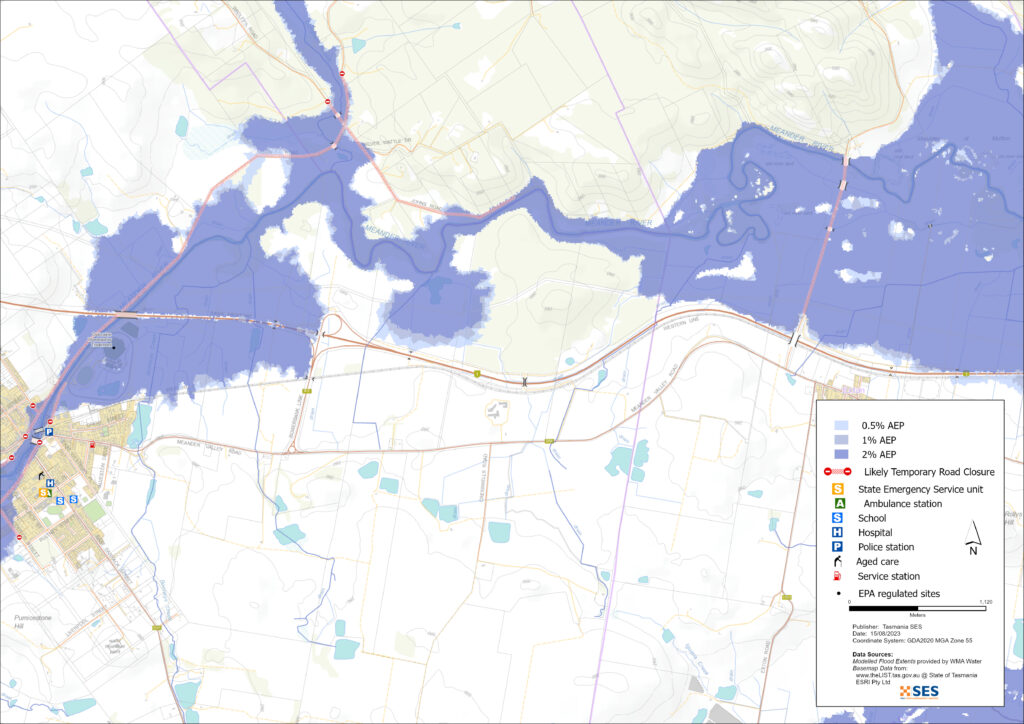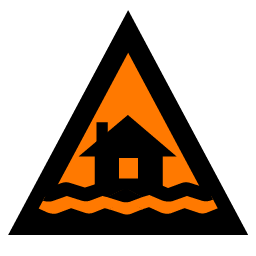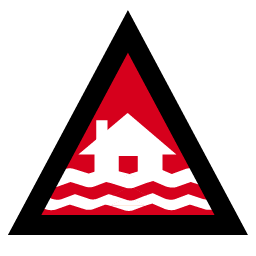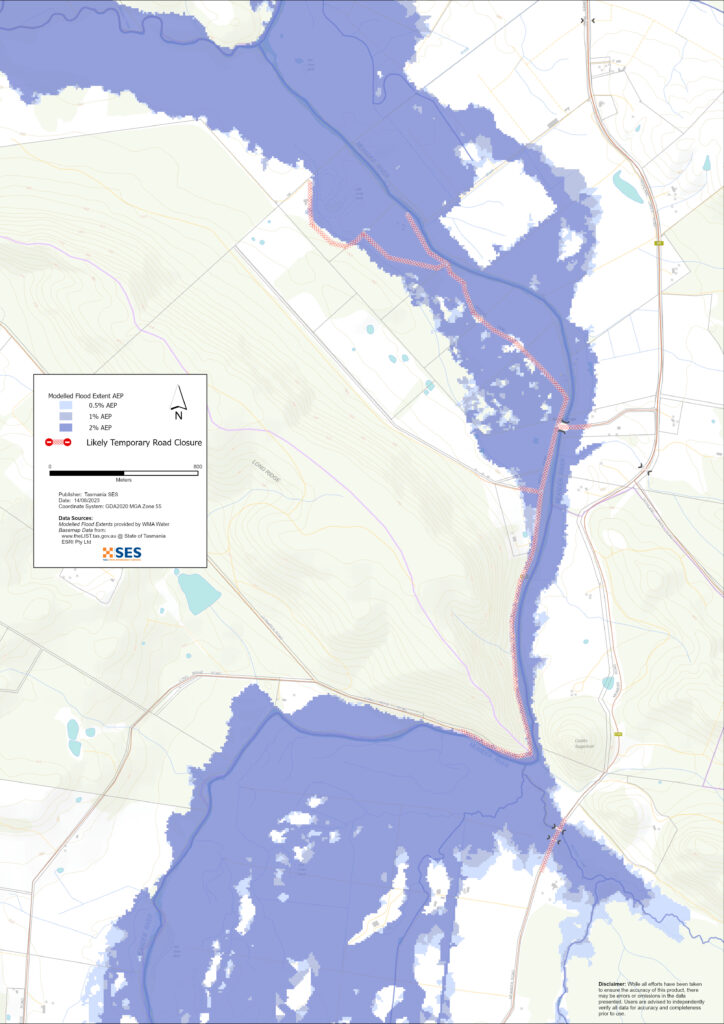Riverine flooding information for the Meander River

Deloraine and surrounds can flood from the Meander River. The map shows the expected Major Flood levels in the Deloraine area. You are likely to experience a major flood in your lifetime.
In a major flooding event, roads in and around Deloraine are likely to be cut and some areas inundated. Homes and buildings can become flooded above floor levels. If you need to evacuate, you should leave early, before flood waters rise. Listen to ABC local radio for warnings and advice.
In such flooding events, properties to the south of Deloraine may become isolated due to flooding of the Highland Lakes Road. Isolation of the Reedy Marsh area may occur due to flooding of River Road and Porters Bridge Road. Minor roads may also be cut by flooding, landslips or fallen trees. It is dangerous to drive through flooded roads, particularly in isolated areas.
Even if your home is not inundated, you may be isolated for several days before flood waters recede. You should have supplies for up to three days and be prepared for power and telecommunications outages. Note if you are isolated, you may not be able to access medical or other help if needed.
Are you at risk of flood?
- Deloraine and surrounds has a long history of significant flooding with 1876 the first recorded flood event.
- In 1970,1992, 2010, and 2011 Deloraine experienced Moderate flooding events that affected roads, bridges, and buildings.
- 2016 and 2022 were Major flooding events, with the peak of the 2022 flood recording a new record flood height at Deloraine of 4.44m.
What should I do?
- Check the map to see whether your home or business is likely to be at risk during a flood.
- Check if you might not be able to safely get to your home, work, or school during a flood.
- Prepare a Home Emergency Plan. Consider if you need to evacuate before a flood.
- Assess your home or business and prepare it to minimise possible flood damage.

Bureau of Meteorology (BoM) Forecasts, Warnings, and Observations
BoM issues a Flood Watch when predicted weather might cause floods in one or two days. A Flood Watch may
- be for a specific area such as Deloraine, or
- be generalised such as for Great Western Tiers, Central Plateau or Central North forecast district.
BoM issues a Severe Weather Warning for very heavy rain that may lead to flash floodingwhenever this weather is occurring or is expected in an area. The amount of time between the warning and the arrival of heavy rain can vary from an hour to 24 hours or sometimes more.
BoM issues Flood Warnings with specific flood heightsfor the Meander River at the Deloraine Railway Bridge gauging site to provide warnings of flood heights. Flood warnings can be issued for Minor (2.0m), Moderate (2.5m), and Major (3.0m) flood levels.
Understand the warnings and key information
Keep aware of what is happening around you. Check forecasts, observations and warnings regularly.
- TasALERT.com
- your local ABC radio station or
- the Bureau of Meteorology’s website.
 | Advice (Yellow): an incident has started. There is no immediate danger. Stay up to date in case the situation changes. |
 | Watch and Act (Orange): There is a heightened level of threat. Conditions are changing and you need to start taking action now to protect you and your family |
 | Emergency Warning (Red): An Emergency Warning is the highest level of warning. You may be in danger and need to take action immediately. Any delay now puts your life at risk. |
 | Community update (Blue): Specific information and updates for affected communities regarding a particular event or incident. |
| Incident (White): an incident is the initial occurrence of an event before it becomes an emergency warning. As soon as an incident is reported, TasALERT published basic information including the type and location of incident. |

No two floods are the same. Floods like the one shown in the map or worse will occur again.
If you live in a low-lying area you may be at risk of flooding. Even if your home is safe, you may need to detour around flooded areas. Never drive through or enter flood waters.
Knowing what to do can save your life and help protect your property. Preparing a Home Emergency Plan is one of the best ways to prepare.
Include weather and rainfall triggers for action in your Home Emergency Plan.
Flood levels at Deloraine and surrounds
While no two floods are the same, the following table shows what you can expect at different flood levels around Deloraine. Even if your property is not flooded, you need to think about access routes.
A Minor Flood means
- The river channel has filled and may spill over into some low-lying areas.
- Livestock should be moved from low lying land.
- No roads are flooded
- No buildings are impacted by flooding.
A Moderate Flood means
- Spill over riverbanks and water covers larger areas of land, impacting some homes and other buildings.
- Livestock should be moved to the highest land available.
- Highland Lakes Road commences flooding and may be closed before the Major flood level.
Some properties to the south of Deloraine on Highland Lakes Road, Long Ridge Road and Sisters Lane can become isolated. - Properties to the north of Deloraine on River Road, Jones Road, Wadleys Road and Silver Wattle Road may become isolated.Some homes and buildings in low areas may be flooded around West Parade and River Road.
- Deloraine Recreation area, the Showgrounds, and the industrial area to the south along Highland Lakes Road become inundated.
- The Meander River Reserve and Deloraine Train Park are becoming extensively flooded.
- The Deloraine Caravan Park is becoming extensively flooded.
- The Deloraine RV Park is commencing to flood the lowest areas.
- The Deloraine Recreation Area is flooded, impacting buildings.
- Deloraine Showground is flooded, impacting buildings.
- Inundation starts in the industrial area to the south of Deloraine, impacting some businesses.
- Restricted to Closed major roads may include Highland Lakes Road.
Minor roads with some areas of flooding may include:
- Racecourse Drive,
- River Road
- Westbury Place
- Bonney Street
- West Parade
- East Parade
- East Goderich Street
- Johns Road, Wadleys Road and Silver Wattle Drive
- Long Ridge Road and Sisters Lane
- Meander Road near the Highland Lakes intersection
A Major Flood means
- Extensive flooding of the floodplain areas, with increasing impact on homes and other buildings.
- Livestock should be removed from the floodplain areas if no higher ground is available.
- Increased and extensive flooding of Highland Lakes Road.
- Properties within the greater Reedy Marsh locality can become isolated as Porters Bridge Road becomes inundated.
More buildings are likely flooded above floor level including:
- Homes along Sisters Lane and Long Ridge Road
- Homes along River Road
There may be utility outages (power, water, sewerage etc.)
The Meander River Reserve and Deloraine Train Park are flooded and is dangerous because of deep and fast-moving floodwater.
There is deep and fast-flowing flooding in the town’s northern floodplain, including the Deloraine Recreation Area, and the southern floodplain, including the Deloraine Showground.
- Extensive flooding of the southern industrial area.
- Highland Lakes Road is closed with extensive flooding.
Further minor roads that may be inundated include:
- Porters Bridge Road – Isolation of Reedy Marsh area
- Lansdowne Place
Increased flood depth and extent along all roadways impacted by flooding.
Know your risk, get ready, reduce risk where you can, connect with others, stay alert and act safe.
Before a flood
1. Know your risk
Flooding often happens in Tasmania and can cause widespread and significant damage. In the past 200 years there have been 78 flood related deaths in Tasmania. This guide is to help you understand flood risk in your area.
2. Prepare your household
Have an emergency plan that covers storms and floods
Thinking about what you would do in a storm or flood means you are more prepared and everyone is safer. Have an emergency plan that everyone in your household understands. There are checklists to help you think through your plan – see the SES website or Red Cross Rediplan.
Check your plan regularly and test it by everyone in the household thinking through a flooding scenario that may affect your household.
Prepare an Emergency Kit
Ready to Go
- Battery powered radio and torch, spare batteries
- Important information, such as your emergency plan
- A list of emergency numbers
- Food and water
- First aid kit
- Rubber or strong leather gloves
Pack when needed
- Warm clothes, sturdy shoes or boots
- Medicine, glasses or other essential items
- Mobile phone and phone charger
- Pet food and anything else they need
- Photos and special keepsakes
- Money
- Important documents, for example
- insurance papers
- passports and
- birth certificates
Regularly test batteries in radios and torches.
3. Reduce your risk from flooding where you can
- Think about storms, flooding and other hazards when buying, maintaining or developing property.
- Trim or remove trees and branches overhanging your home, business or near powerlines on your property.
- Keep your gutters and drains clear.
4. Connect with others
Know your neighbours and get involved in your community. A connected community is a safer and more resilient community in an emergency and can help everyone recover better afterwards. Check that family and neighbours are safe and aware of what’s happening.
During
5. Keep up to date
Keep aware of what is happening around you. Check forecasts, observations and warnings regularly.
- TasALERT
- your local ABC radio station or
- the Bureau of Meteorology’s website.
6. Act Safe
- Supervise children.
- Prepare for possible power, water or internet outages.
- Check your emergency kit is ready to go.
- Keep clear of flooded areas such as drains. NEVER walk, play, ride or drive in floodwater. You can’t always see what is under the water or how deep or fast-moving the water is. It is easy to be swept away and drown in as little as 20cm of fast-moving water. Flood water can be dangerous.
When your home may be flooded
- Put household items up high to minimise possible damage.
- Turn off the electricity and gas if it is safe to do so.
- A great way to stop sewerage flowing back into your home is to place sandbags inside plastic bags and use them to block toilets and cover drains and sinks.
- Leave while you can get out safely.
If you need to evacuate
- Follow the advice from SES / Tasmania Police.
- Take your emergency kit.
- Go to friends or family in a safer place or an evacuation centre.
- Let others know where you have gone.
Look after your animals
You are responsible for your animals in an emergency. If you have pets and other animals it will take you longer to evacuate in a flood or other emergency. Move livestock from flood prone areas well before flood waters may rise. For more information see
- RSPCA’s guidance on preparing for animals in an emergency
- the Primary producer farm flood readiness toolkit.
Avoid travelling during and after storms
- Do not go sightseeing. Sightseers delay emergency services and cause accidents.
- Watch out for hazards such as
- water over roads
- damaged powerlines
- landslides
- damaged roads
- falling trees or roofing iron.
- Never drive through flood waters. Most deaths and rescues in floods are from people driving through flood waters.
- Drive slowly and turn your headlights on roads not affected by flood waters.
After
- Keep listening for ABC Local Radio updates, road re-openings, community meetings, etc.
- If you left your home, do not return home until SES or Tasmania Police tell you it is safe to do so.
- Be aware of road hazards, such as mud or debris on the road, damaged roads/bridges and crews working on clean-up and repairs.
If your home has been damaged
- Stay at ground level while checking for damage. Be careful of fallen trees, broken glass, loose roofing or other hazards.
- Wear strong boots, gloves and protective clothes.
- Use a torch, never use matches or candles inside flood affected buildings.
- Boil all drinking water until you are told the tap water is safe again.
- Do not turn on it is tested by a licensed electrician or gas fitter for safety.
- If your home is damaged and you need to stay somewhere else, take your emergency kit and pets with you
- Take photos of any damage if safe for you to do so and contact your insurance company.
- Supervise children.
- Check neighbours are okay.
For further information go to www.ses.tas.gov.au
Staying informed and further information
Current warnings (TasAlerts) alerts.tas.gov.au
Bureau of Meteorology (BoM)
Emergency Broadcasters ABC 936AM
TASSES Social Media
facebook.com/sestasmania
twitter.com/sestasmania
Preparing for Flood Emergencies ses.tas.gov.au/plan-prepare/flood
Meander Valley Council meander.tas.gov.au 6393 5300
National Relay Service (NRS) relayservice.gov.au

